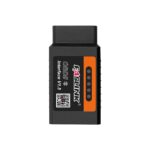Tesla vehicles, specifically the Model 3 and Model Y, don’t use a standard OBD2 port like most gasoline-powered cars. Instead, they utilize a unique diagnostic port located in the rear passenger compartment. This port requires a specific adapter to connect with standard OBD2 tools and software. So, while Tesla doesn’t directly use OBD2, you can still access vehicle data using an adapter and compatible OBD2 equipment.
Accessing Tesla Data with an OBD2 Adapter
The Tesla Model 3 and Y’s diagnostic port requires a cable adapter and an OBD2 tool or device compatible with ELM327 or STN1110 protocols. Popular choices for OBD2 tools include the OBDLink LX and MX Bluetooth devices. To connect, you’ll need a Tesla-specific OBD2 adapter.
Tesla’s advanced security measures prevent unauthorized modifications to critical systems. Connecting to the diagnostic port primarily allows access to live vehicle data through diagnostic apps. Two prominent apps for this purpose are Scan My Tesla and TM-Spy, available for both Android and iOS.
Scan My Tesla: Live Data at Your Fingertips
Scan My Tesla provides a comprehensive overview of real-time vehicle statistics, including:
- Battery: Power, voltage, current, and temperatures
- Drive Unit: Electric power, torque, horsepower, RPM, and temperatures
- Battery Health: Lifetime stats, capacity estimates, and mileage
- 12V System: Current, voltage, and temperature
- Trip Data: Recording and statistics, including charging details
- HVAC: Controls and readings
TM-Spy: Deep Dive into Battery Data
TM-Spy delves deeper into battery specifics, offering information such as:
- Individual Cell Voltages: Detailed voltage readings for each battery cell.
- Voltage Extremes: Maximum, minimum, and the difference between them.
- Battery Balance: A histogram visualizing the balance of the battery pack.
- Temperature Sensors: Readings from the battery pack’s temperature sensors.
- Battery Performance: Total voltage, current, capacity, remaining energy, and mileage.
- Energy Usage: Lifetime battery discharge and charge energy.
The Power of the Tesla Community
The data utilized by these apps is largely thanks to the Tesla community’s efforts in identifying and documenting the Model 3’s CAN bus IDs and data. This collaborative effort enables comprehensive data access and analysis for Tesla owners.
Conclusion: Accessing Your Tesla’s Data
While Tesla doesn’t use a standard OBD2 port, access to vehicle data is still possible. By using a Tesla-specific OBD2 adapter and compatible software like Scan My Tesla or TM-Spy, owners can monitor various vehicle parameters and gain valuable insights into their car’s performance and health. This access, driven by the Tesla community’s collaborative spirit, empowers owners with knowledge and control over their electric vehicles.
